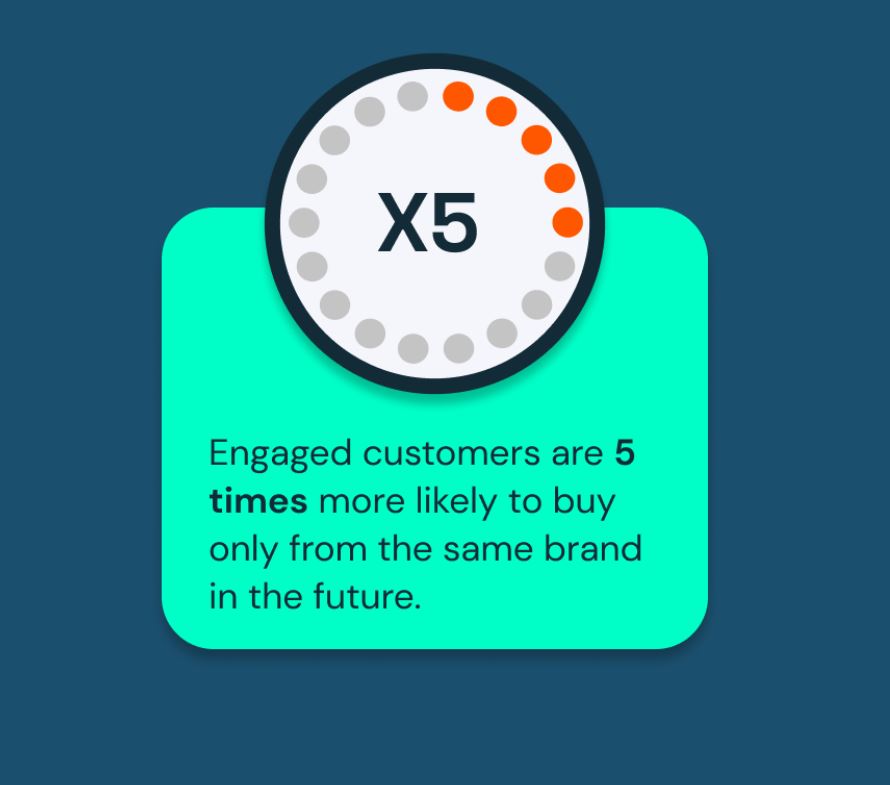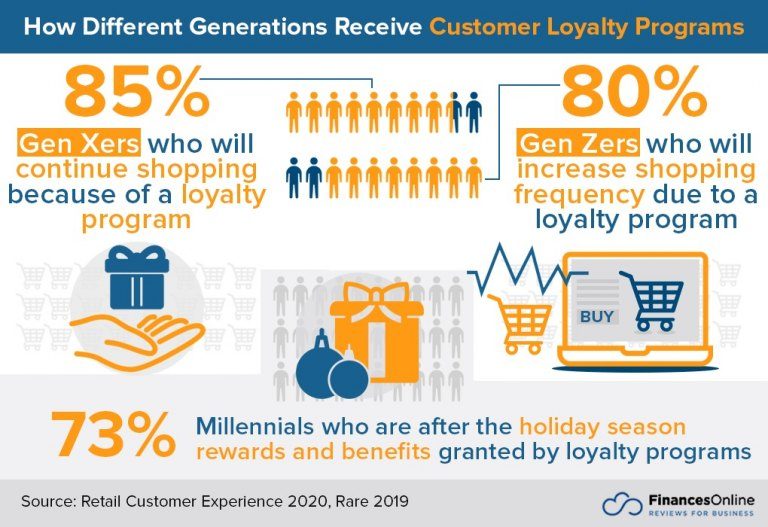Turn customers into loyal fans! This guide explores winning strategies to boo...

In today's oversaturated market, where new products and services emerge daily, customer engagement is the key differentiator. A well-crafted customer engagement strategy improves loyalty and keeps customers coming back for more. But with so many touchpoints available, how do you cut through the noise and truly connect?
This article explores the importance of strategic customer engagement planning and how to increase customer engagement, helping you create a memorable experience that keeps your brand at the forefront.
Customer engagement is the continuous process of a company building relationships with customers. It involves understanding their needs, preferences and pain points. Companies engage customers through different strategies, such as creating helpful content, loyalty programs, personalized emails, and social media interactions. These efforts create a strong and loyal customer base, which is more likely to return for future purchases.
While often confused with customer experience, engagement is the action of building relationships, while customer experience is the customer's perception of those interactions throughout their journey.
Customer engagement strategy is the action plan to improve customer engagement and create a positive experience throughout their journey with your company. It ensures a smooth and memorable experience from their first interaction to post-purchase support.
Here are the key stages followed throughout a customer engagement strategy:
According to a study by McKinsey, 70% of buying experiences are based on how the customers feel they are being treated. The way you interact with your customers directly influences your brand perception. A solid customer engagement strategy goes beyond making customers feel good. It positively impacts your bottom line by boosting revenue, customer retention, and loyalty in the long run.

Now, let's explore the key benefits of effective engagement strategies:
Every customer interaction with your brand contributes to their overall experience. However, customer engagement plays a critical role in shaping that journey. It involves proactive interactions that build relationships and address customer needs.
Remember, customer experience is a key deciding factor in whether someone chooses your brand, and 86% of people are willing to pay more for a better customer experience. You can significantly enhance the customer experience by implementing a personalized engagement strategy.
This translates to a smoother journey that enhances customer satisfaction and influences purchasing decisions.
Positive customer engagement fosters trust and satisfaction, making customers more receptive to upsell and resell opportunities. For instance, a customer who likes a new pair of hiking boots might go for high-quality socks or a backpack through engaging conversation or targeted email marketing. This personalized approach leads to long-term customer relationships and generates additional revenue.

Remember how you tell friends about a great new coffee shop or car? Positive customer engagement creates that same effect for your brand. At least 93% of customers are influenced by online reviews for their purchases. With so many platforms available, such as websites, Facebook, and Instagram - potential customers are looking for recommendations before they buy.
By engaging with your customers and building positive relationships, you turn them into promoters who spread the word about your brand, leading to more sales and, ultimately, more revenue.
An effective customer engagement strategy encourages two-way communication. By connecting with customers at different stages, you gain valuable feedback on your products, services, and overall experience. These insights, both positive and negative, highlight areas that are working well and identify opportunities for improvement. You can create a truly exceptional customer journey by integrating this feedback into your marketing and customer support strategies.
It is well-known that retaining existing customers is more cost-effective than acquiring new ones. However, it is only possible when you provide them with the customer experience they want. A bad experience can quickly lead a customer elsewhere. Research shows 86% of customers will leave a brand after two poor experiences.
Customer engagement strategies help you build loyalty by addressing customer needs and fostering positive relationships. This reduces churn and keeps your valuable existing customers happy and returning for more. The good news is that returning customers spend 67% more than new customers.
Let's explore some of the best customer engagement practices and how to implement these strategies in sales, marketing, research, and customer service. This will help you deliver true value to your customers and maximize the impact on your business.
In a world of products and materials, business thrives on human connection. The most impactful customer engagement strategy starts by humanizing your brand. Share your vision, mission, and goals - the "why" behind your business. Explain how you aim to improve lives using storytelling, one of humanity's oldest connection tools.
By letting people see the humans behind the brand, you build trust and make genuine connections that lead to lasting customer engagement.
Building a successful customer engagement strategy requires a deep understanding of your customers. Start with mapping your customer journey. It involves pinpointing all touchpoints, including website visits, phone calls, and social media interactions. Where do customers interact most? What challenges do they face? You gain insights into customer behaviour, preferences, and potential pain points by analysing this journey.
The intent behind every business is to improve its customers' lives. Strong customer engagement goes beyond just selling. A powerful strategy is to provide value through education and awareness. Offering helpful, relevant content like blogs, articles, guides, or social media posts establishes you as an authority in your field.
For example, a fitness clothing company could offer workout guides or healthy recipe blogs. This valuable content doesn't directly sell clothes, but it builds trust, keeps customers engaged, and positions the brand as a partner in their overall well-being.
No business is perfect, and complaints are inevitable. However, they present a valuable customer engagement opportunity. By actively listening to customers' complaints and showing empathy, you gain crucial insights into areas for improvement. Acknowledge their feelings and work towards solutions. According to a survey, 83 % of customers feel more loyal to brands that respond to and resolve their complaints.
Acknowledging customers' feelings and working towards solutions shows you care, transforming frustration into loyalty and a stronger customer relationship.
Loyalty programs are an effective and rewarding customer engagement strategy**.** Offering rewards like discounts, early access to new products, or exclusive gifts incentivizes customers to interact and purchase more from your brand. This resonates particularly with Gen Z and Millennials, who value experiences and personalized offers.
For example, A coffee shop might offer a loyalty program where customers earn points for every purchase. These points could then be redeemed for free drinks or snacks.

Modern customers expect a personalized experience from businesses. Generic newsletters and emails no longer work; these messages often land in the spam folder and fail to resonate. Show your customers you understand them and respect their choices.
Leverage customer data from various sources like live chat, CRM systems, and purchase history to personalize your offerings such as:
Today's customers expect support whenever they need it. Move beyond traditional business hours by offering a combination of AI chatbots and live chat functionalities. AI chatbots powered by NLP and machine learning can provide 24/7 assistance with basic inquiries, product information, and order updates.
Live chat with human agents remains essential for complex issues or customers who prefer a personalized touch. This combined approach ensures a seamless customer experience, regardless of the time zone or day of the week.
Successful customer engagement thrives on open communication. To ensure your strategies resonate with your audience, avoid a one-sided approach. Regular customer feedback collection is crucial. Use various channels - live chat interactions, surveys, or engaging questions- to gather honest opinions and reviews.
Remember, feedback isn't just about collecting data; it's about acting on it. Demonstrate you value their input by implementing improvements based on their feedback. This closed-loop approach fosters trust and shows your dedication to continuous improvement.
Effective customer engagement isn't about bombarding customers with constant promotions. It's about building quality relationships through exceptional service, personalized interactions, and valuable content. By implementing a multifaceted strategy that includes enhanced customer service, AI support, feedback mechanisms, and ongoing education, you can create a customer experience that fosters loyalty and keeps them returning for more.
AI customer service plays a key role in facilitating this process. AI chatbot customer service helps you handle basic inquiries 24/7, freeing up human agents for complex issues. This ensures customers receive prompt and efficient support, regardless of the time zone or day of the week.
Do you want to create an exceptional customer engagement strategy? Visit our website and see how our AI ecosystem can help you achieve that.
Customer engagement can be divided into categories based on approach and purpose. Here are a few examples:
Make real connections and increase customer engagement through personalizing email marketing, running interactive social media contests, or gamifying your loyalty program with points, badges, and challenges.
There are several ways to measure the success of your customer engagement strategy. Some key metrics include: